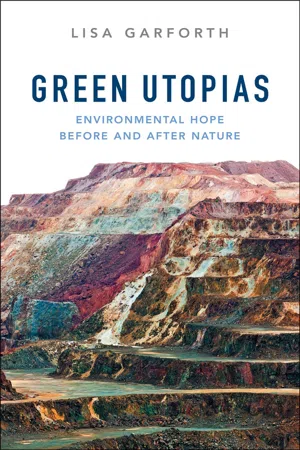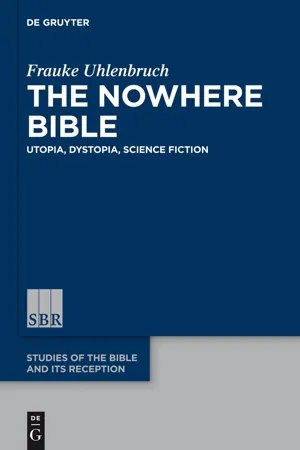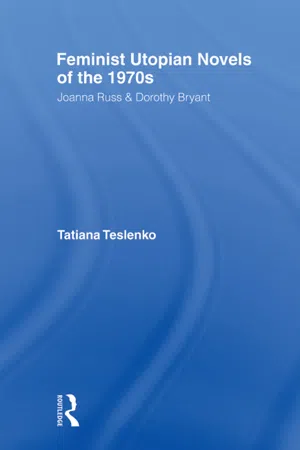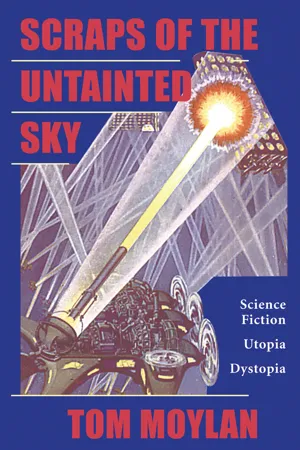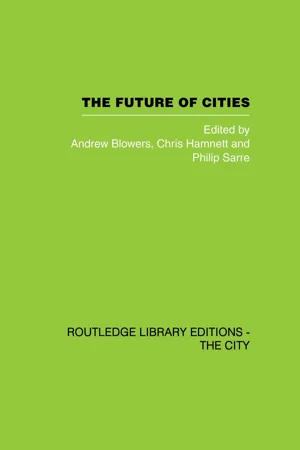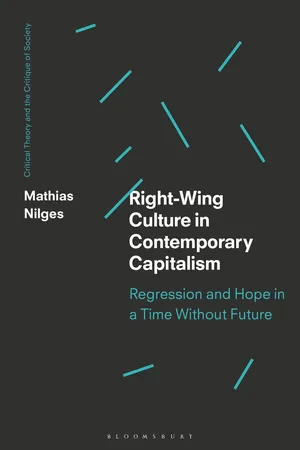Literature
Utopian Fiction
Utopian fiction is a genre of literature that presents an idealized society, often characterized by harmony, equality, and abundance. These narratives typically explore themes of social and political change, envisioning a world free from the flaws and injustices of the present. Utopian fiction encourages readers to contemplate alternative ways of organizing society and to reflect on the possibilities of a better future.
Written by Perlego with AI-assistance
Related key terms
Related key terms
1 of 4
Related key terms
1 of 3
11 Key excerpts on "Utopian Fiction"
- eBook - ePub
Utopian Drama
In Search of a Genre
- Siân Adiseshiah(Author)
- 2022(Publication Date)
- Methuen Drama(Publisher)
Nineteen Eighty-Four (1949). The 1970s revival in Utopian Fiction – in the form of the critical utopia – included the depiction of dynamic feminist utopian spaces that were more provisional, unstable, and in process than had been imagined in previous Utopian Fictions. Contemporary utopian and dystopian fiction of the late twentieth and twenty-first centuries resides predominantly in the genre of science fiction – for example in the work of Kim Stanley Robinson, Margaret Atwood, and Brian Aldiss, and in the twenty-first century explosion of young adult speculative fiction. The genealogical development of the genre of Utopian Fiction is well established and has served effectively as a contextual framework for appreciating contributions of individual utopian novels.However, the novel’s ubiquity in scholarly discussion of the literary utopia has had the unfortunate effect of obscuring other literary and cultural forms, along with neglect of the cross-fertilization that emerged from the novel’s relationship with other forms. Jameson reflects this tendency in his observation that a distinction of Utopian Fiction is self-conscious dialogue identifiable across the canon of utopian prose narratives: ‘what uniquely characterizes this genre is its explicit intertextuality: few other literary forms have so brazenly affirmed themselves as argument and counterargument’.26 An exclusive focus on the diachronic development of the utopian novel at the expense of its encounter with other forms has been reinforced by theorists of the novel, such as Mikhail Bakhtin, who argues that the novel ‘gets on poorly with other genres’, and that other genres, such as dramatic naturalism, take on a novelization of style.27 - eBook - ePub
- Carlos López Galviz, Emily Spiers, Carlos López Galviz, Emily Spiers(Authors)
- 2021(Publication Date)
- Routledge(Publisher)
It is closely associated with the literary form that More initiated, but not reducible to it. Utopian Fiction continues to flourish, 1 but the form has become less didactic and static (Ferns, 1999), more reflexive, open and ‘critical’ (Moylan, 1986 ; Wagner-Lawlor, 2013). The utopian impulse is vividly present in texts that are formally dystopian, or anti-utopian (see Moylan, 2000 ; Moylan and Baccolini, 2003 ; Viera, 2013; Stock, 2018), or more broadly speculative, fantastical and magical realist (see Edwards, 2019). 2 Utopia is inseparable from the content of radical political visions – Marx and Engels’ communist and Haraway’s cyborg-feminist manifestoes (Weeks, 2013); green blueprints for the end of growth (Garforth, 2017) and post-capitalist visions of automation and a universal basic income (Srnicek and Williams, 2015). But utopia cannot, as Levitas shows (2010, p. 5), satisfactorily be defined by its content. Theorists have also located a utopian impulse (albeit a conservative one) in the technocratic third way politics of the 1990s; in contemporary populism and in the supposedly anti-utopian hegemony of neoliberalism itself (see Zizek, 2009, p. 79; Bell, 2017, p. 23; Bregman, 2017, p. 244). As form and content have become less central to definitions of utopia and it becomes harder to pin down what utopia is, debates have centred increasingly around questions what utopia does. Levitas (2010) traces the idea of approaching utopia in terms of its function or effect to Marx and Engels’ rejection of utopian socialism on the grounds that detailed visions of a better society compensate for or distract from real struggles and historical transformation. More recent traditions in utopian studies focus on the capacity of utopian images and impulses to challenge or unsettle the way things are (Bammer, 1991 ; Jameson, 2005 ; Sargisson, 2012). Utopia here is about the refusal of the status quo in the name of something better - eBook - ePub
Green Utopias
Environmental Hope Before and After Nature
- Lisa Garforth(Author)
- 2017(Publication Date)
- Polity(Publisher)
By the 1970s, science fiction was renewing an already established tradition of writing on ecological themes. Throughout the twentieth century, science fiction and fantasy had imagined near and far future ecosystem collapse, invading alien ecologies, and the colonization and terraforming of other planets (Stableford 2015). Depictions of utopian relationships between nonhuman nature and human societies have featured strongly in fantasy writing, often pastoral or Edenic in tone, set in a pre-industrial world of organic harmony. Apocalyptic science fiction had imagined much simpler post-holocaust worlds in which the survivors learned to rely anew on a depleted earth. In the 1960s, eco-dystopias had emerged showing fictional futures characterized variously by food shortages, population explosions and authoritarian politics; by the crass commercialization of nature and decadent squandering of environment resources; and by mysterious events in which nature runs wild. The three novels discussed here reconfigure these themes in very distinctive ways by confronting the prospect of systemic, human-made environmental crisis, elaborating on themes derived not just from ecosystems science, but from ecopolitical philosophy, and expressing both the warning of limits and the insights of the emancipatory ecology discussed.These novels also respond to questions of sufficiency, development, justice and nature addressed through the longer history of Utopian Fiction. More's Utopia, published in 1516 and in part a response to the violence and poverty of Tudor England, suggested a simple but comfortable existence carefully balanced between agricultural stability and economic development. As modernity progressed, the tension between utopias of abundance and utopias of sufficiency (De Geus 1999) became more marked, however. Utopias depicting economic expansion and technological development diverged from those imagining the limitation or reconfiguration of human wants in relation to natural systems and modest production (De Geus 1999: 21–2). This contrast is very visible in relation to two competing visions of the nineteenth century. Morris's News from Nowhere presented a medievally influenced Arcadia with small-scale craft work and communal life. Urban and industrial structures were gently overtaken by organic growth. Bellamy's Looking Backward represented the socialist future via metaphors of the machine and with the assumption that perfect economic efficiency would enable human happiness. Around the same time, Gilman's Herland described a society of women living entirely in harmony with a pastoral landscape; and in the 1960s Huxley's Island - eBook - ePub
- Frauke Uhlenbruch(Author)
- 2015(Publication Date)
- De Gruyter(Publisher)
Suvin sees the thematic nucleus of the literary genre of utopia as the depiction of an “imaginary community in which human relations are organized more perfectly than in the author’s community.” 154 This perfection, he points out, does not have to be “absolute perfection” but rather means “a state radically better or based on a more perfect principle than that prevailing in the author’s community.” 155 If we follow this definition by Suvin, it might mean that it is possible to reverse utopian images to say something about the creating community. The reality of the community is not always described in the utopia because the empirical circumstances would have been known to its target audience. In the case of biblical examples, it might be difficult to make reliable statements about the circumstances behind the utopia, because different editorial layers must lead us to assume that there is not one empirical reality behind it upon which we can conclude but multiple realities in slightly different cultures and times. We can say something about utopias and their appeal to a committed community of readers by looking at the Bible. In the Bible, the imaginary community, projected into a more or less distant past, is not entirely imaginary to a hypothetical “committed” reader of this text. The continuous narrative about “us” – a category perpetually reinforced by stories about encounters with “them” and reinforced by genealogical connections given everywhere, makes biblical utopian passages appealing and topical, especially to such readers who would consider themselves to be descendants of the biblical genealogy (by whichever theological or pseudo-scientific argument they were led to this conviction) - eBook - ePub
The Planetary Humanism of European Women's Science Fiction
An Experience of the Impossible
- Eleanor Drage(Author)
- 2023(Publication Date)
- Routledge(Publisher)
2 Contextualising the History of Science FictionDOI: 10.4324/9781003398103-31 Utopia and Science Fiction
Utopia or eutopia,1 the umbrella term that includes Utopian Fiction (which, to simplify, imagines a better place), and dystopian fiction (a worse one), has a complex and intimate relationship with works of SF that explore issues of race and gender. This is because, as theorists such as Kilgore have demonstrated, the anticipatory power of utopian speculation is a productive tool with which to reformulate race and gender in science fictional worldbuilding. Indeed, SF, which often offers a space beyond the impediments of the present, including the systemic crises issued by racial and gender oppression, engages in a utopian retrieval of alternative universes. The affinity between utopia and SF, as they seek other places, spaces, and realities, presents itself as akin to a Venn diagram: their methods and ambitions overlap at times and disunite at others. This relationship has been described at length by utopian scholars from Darko Suvin and Raymond Williams to Frederic Jameson and Edward Chan.For Suvin, utopia is specifically the “sociopolitical subgenre of SF” (61). Where utopia locates an unchartered place in “this world”, Suvin suggests that SF occupies itself instead with the extraterrestrial, the spaces beyond this earth (42). Raymond Williams’ 1978 essay “Utopia and SF” extends the differences between SF and utopia beyond geographical ones, identifying four categorical certainties to describe and delineate what distinguishes SF from utopia, and where the overlaps occur. Though Williams advises that it is “tempting to extend both categories until they are loosely identical, and it is true that the presentation of otherness - eBook - ePub
Feminist Utopian Novels of the 1970s
Joanna Russ and Dorothy Bryant
- Tatiana Teslenko(Author)
- 2003(Publication Date)
- Routledge(Publisher)
critical in as much as it provides for “[an] idea to become flesh, abstraction to become concrete, imaginative extrapolation to become aesthetic reality” (Annas 145). The very success of the feminist intervention in the patriarchal utopian genre becomes possible because of a strong feminist desire for social dreaming. The new utopian genre has a dialogic and intertextual relationship with the feminist rhetoric of the 1970s, articulating its revolutionary message and vocalizing the concerns of the feminist discourse community of the time.Passage contains an image Table 1. Index of Utopian Terms
Utopianism Social dreaming Utopia A nonexistent society described in considerable detail and normally located in time and space. Eutopia or positive utopia A nonexistent society described in considerable detail and normally located in time and space. The author intends a contemporaneous reader to view this society as considerably better than the society in which that reader lives. Dystopia or negative utopia A nonexistent society described in considerable detail and normally located in time and space. It is intended to be considerably worse than the society in which the reader lives. Utopian satire A nonexistent society described in considerable detail and normally located in time and space. It presents a criticism of the contemporary society. Anti-utopia A nonexistent society described in considerable detail and normally located in time and space that is aimed to criticize utopianism or some particular eutopia. Critical utopia A nonexistent society described in considerable detail and normally located in time and space. Its function is to portray a better society than the contemporary one. However, this society has difficult problems that the described society may or may not be able to solve. This narrative takes a critical view of the utopian genre. - eBook - ePub
- Barbara Goodwin(Author)
- 2012(Publication Date)
- Routledge(Publisher)
Ch.l ). It is my argument here that at least part of what we imagine is a Utopian national community, based on the images of that community found in the traditional materials of utopianism. It is my further contention that the imagined communities and the Utopian expectations regarding that community change over time in relationship with each other.One way of thinking about the relationship is through national myths. Every country teaches its children stories about its past that are either demonstrably false or simply shaded to put the nation or its founders or leaders in a particularly good light. These myths are part of the creation of national identity and frequently have a distinctly Utopian tinge to them if they are not explicitly Utopias themselves. These myths are part of a collective national memory or subgroup memories that include many eutopian and dystopian stories and experiences. Utopian literature frequently uses these memories to build either the justification for overcoming the past or support for the future eutopia.The Problem of Britain
As the country of origin, Britain poses a different set of problems from the colonies, problems that may be particularly intractable. The genre of literature that is called Utopian was invented by Thomas More (1478–1535) in his Libellus vere aureus nec minus salutaris quam festivus de optimo reip[ublicae] statu, deq[ue] noua Insula Vtopia of 1516, in which he played with the words ‘utopia’ and ‘eutopia’. It is obvious that Utopias existed before 1516, but it is equally obvious the More’s little book added a word that has been adopted by all languages that have come into contact with the idea.5The idea caught on as well as the word. Glenn Negley (1978) lists 22 sixteenth-century Utopias in the main section of his bibliography (and many more in his list of ‘Works Influential on Utopian Literature’), and he was unaware of the earliest post-More Utopia written in English, that is, the Utopian section of William Bullein’s A Dialogue both pleasante and pietifull (1573).6 - eBook - ePub
Scraps Of The Untainted Sky
Science Fiction, Utopia, Dystopia
- Thomas Moylan(Author)
- 2018(Publication Date)
- Routledge(Publisher)
Even within Jameson's utopian problematic, there is no reason to neglect the relative importance of the content of utopian texts. As Fitting notes, the pedagogical adventure of Utopia most often begins with the popular reception of the alternative world by readers seeking critique and change. Yet the dialectical understanding of the utopian process also demands that scholars take care not only to examine and assess the narratives and images of the literary utopia in the fullness of their relationship with the ideological matrix from which they emerge and with which they contend, but also to investigate the complex influence of the historical situation and the political process on the author's decisions regarding formal strategies. Wherever the analysis begins, the basic relationship of the interaction of social dreaming with the historical moment is one that frames and shapes the entire utopian project. Any utopian object, therefore, is necessarily multifaceted and multilayered. As the critic's gaze moves from text or community, to theoretical argument, to sociopolitical process, back again to text, and ultimately again to history, the underlying charge of that utopian study lies not simply in the quality of the utopian object but also in the way it speaks back to critic and in the larger intellectual and political engagement it stimulates.In our time especially, as Jameson argued in 1971, the use value of Utopia, in whatever form it takes and in whatever content it advances, lies in its ability to challenge the limitations of "practical thinking" (or what the Frankfurt School calls "instrumental reason") by way of its impossible demands being realistically put into play in the realm of scholarship as well as in the realm of oppositional politics. The utopian idea, therefore, "keeps alive the possibility of a world qualitatively distinct from this one and takes the form of a stubborn negation of all that is" (Marxism and Form - eBook - ePub
Becoming Utopian
The Culture and Politics of Radical Transformation
- Tom Moylan(Author)
- 2020(Publication Date)
- Bloomsbury Academic(Publisher)
And over the last few decades, especially from the 1990s, utopian writing has gone through further shifts, as in the critical dystopias, new iterations of the critical utopia, and fantasy with writers like Miéville and Phillip Pullman. 2 And so, in this chapter, I want to open a line of thought about utopian sf and fantasy that addresses the power of utopia’s strong thought. That is—given the formal disruption of the prevailing Denkverbot (as the editors of the Lenin Reloaded volume call the current prohibition on alternative thinking)—what can we then say about the positive hermeneutic that ensues? I will begin with two preliminary points. 3 The first is to note the inevitable importance of content in the literary utopia, wherein the textual details of alternative social values and political practices that are rendered invisible by the prevailing common sense are foregrounded with the intention of being taken seriously by readers, before, they deliquesce back into the very form by which they were given imaginative life. However much this content comes to us by way of estranged figuration, the subject matter has always mattered. From Thomas More and Margaret Cavendish to H. G. Wells and Charlotte Perkins Gilman to Ursula K - eBook - ePub
- Andrew Blowers, Chris Hamnett, Philip Sarre(Authors)
- 2014(Publication Date)
- Routledge(Publisher)
design. Here the quantity of material is not so great and the selection problem simpler: the two authors we have chosen demand mention in any discussion of twentieth-century urban design. Finally, since any ideal future city must combine social and physical organization, we include an excerpt from a work which did much to synthesise the two Utopian traditions and translate them into a practical programme.The first extract from the literary tradition is from the work which gave the genre its name—More's Utopia. It consists of two books, the first of which lays bare the evils of sixteenth-century society. The second book presents an alternative ideal community. It has been variously interpreted as a socialist manifesto or a blueprint for a reformed Christianity. More's central concept is the community of property in which only necessities are produced and the welfare of all is ensured. In such a situation, competition for personal advancement is absent, money is irrelevant, and economic equality prevails. Although a system of direct democracy has been instituted, a paternalistic rule is exercised and individual freedom is constrained by communal surveillance and a strict moral code. The chief goal of Utopian society appears to be the pursuit of happiness which consists in 'every motion and state of the body or mind wherein man hath naturally delectation'.In Book 2, the philosopher-traveller Raphael Hythloday describes Amaurote the capital city of Utopia which is designed to encourage individual families to participate in the communal life. He then explains the economic system of Utopia and some aspects of its social organization. He ends his discourse with the extract we have reproduced which compares the virtues of the Utopian commonwealth with the selfishness and exploitation that characterises contemporary (that is sixteenth-century) society and, one might add, that of our own day. - eBook - ePub
Right-Wing Culture in Contemporary Capitalism
Regression and Hope in a Time Without Future
- Mathias Nilges(Author)
- 2019(Publication Date)
- Bloomsbury Academic(Publisher)
Instead, the novel functions as a form of critique and as a form of praxis that anticipates the transformation of material reality by giving us the kind of utopian thought that creates change through a confrontation with what is missing. Alain Badiou argues that precisely because literature is able to “open up to the realm of thought the singularity of whatever takes place outside that realm,” it ought to be considered a “form of thought.” 392 “Literature,” he adds, “is a direct contradiction of Wittgenstein’s axiom (‘Whereof one cannot speak, thereof one must be silent’),” since what Badiou calls “literature’s first axis” is “the imperative to speak of the unspeakable.” 393 Because it speaks the unspeakable and thereby points beyond the foreclosures of the now, we can understand literature in general and the novel in particular as one of the most forceful expressions of the particular form of thought that is utopia. Fredric Jameson reminds us that “the Utopian text does not tell a story at all.” Instead, he argues, “it describes a mechanism or even a kind of machine, it furnishes a blueprint rather than lingering upon the kinds of human relations that might be found in a Utopian condition or imagining the kinds of living we wish were available in some stable well-nigh permanent availability.” 394 Likewise, rather than sketching out for us futures that will never come to pass, the utopian core of the novel lies in its ability to establish the basic mechanisms of utopian thought itself. The novel provides us with a concrete example of this mechanism, and it is in this sense that it can be understood as a form of thought and as a form of the utopian imagination that is aimed at the transformation of the existing. The novel’s relatively ambiguous relation to the world that Kundera describes is an expression of the novel’s formal core that is simultaneously bound up with the form of utopian thought that Bloch outlines
Index pages curate the most relevant extracts from our library of academic textbooks. They’ve been created using an in-house natural language model (NLM), each adding context and meaning to key research topics.
Explore more topic indexes
Explore more topic indexes
1 of 6
Explore more topic indexes
1 of 4


